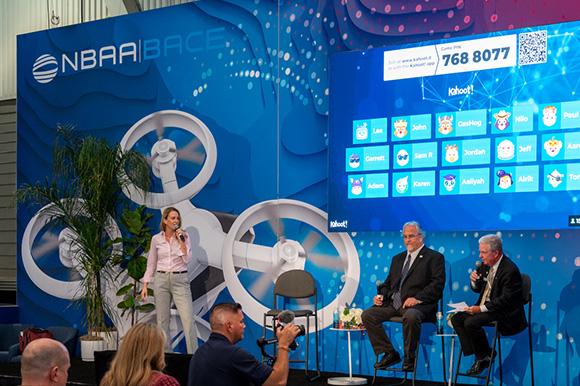
Left to right: “Host” Jessica McClintock, Steve Csonka and Keith Sawyer.
LAS VEGAS—As part of efforts to educate business aviation users about sustainable aviation fuels (SAF) and dispel a few myths, NBAA hosted an unusual SAF “Game Show” event hosted by Jessica McClintock, vice president of FuelerLinx, an aviation fuel flight management software company.
Billed as the “hottest game show on the 2023 NBAA-BACE show floor,” the event featured subject matter experts Steve Csonka, executive director of CAAFI (Commercial Aviation Alternative Fuels Initiative), and Keith Sawyer, manager of alternative fuels at AvFuel. Audience members answered questions via an interactive system to win prizes donated by carbon capture fuel specialist Air Company.
Questions ranged from identifying SAF feedstocks and naming the chemical process used to convert fats, oils and grease into the fuel, to whether engines require modifications to run on SAF. The quiz also sounded out participant’s knowledge on SAF’s environmental benefits, as well as whether it was approved for use globally or just in particular parts of the world.
Commenting on the question about what represents the biggest barrier facing greater adoption of SAF, Sawyer said it continues to be short supply. “Demand exceeds the supply. Last year in the U.S. it was between 15-16 million gal. of neat product produced and it's typically blended at a 30:70 ratio–that’s 30% neat SAF and 70% refined from the two main producing facilities in the U.S. The blended volume is roughly 50-55 million gal. in total. That's very, very small,” he says.
“There are many more projects coming online, and current suppliers are growing their capacity and extending their reach. In my company, we're going to be part of that solution, because we've got to get more product into the supply chain,” says Sawyer. The process also includes boosting national and state-level incentives, including tax credits for blenders.
The shortage of SAF means prices also remain high. “There is a premium and it's not something that you can manage at the present time. But I'm pleased to see the responses that we've had from the business aviation segment. Between 10-12% of the SAF produced last year found its way into a private aircraft,” says Sawyer. “Business aviation consumes only 3.5- 4% of all jet fuel in the U.S, so we're punching above our weight, and we'll continue to do so.”
Csonka urged flight department managers to “talk it up with your organization. Talk up the idea of supporting incentives. Take a hard look at the actual incremental costs associated with running the department and bringing some of those SAFs on board. Some of those business cases may not be as hard to solve as you think. There are a lot of things that we can be doing to help close that gap in the meantime while [CAAFI and others are] still working on bringing the price of these fuels down.”
And in the spirit of full disclosure, your correspondent–nickname “gas hog”–blames slow connectivity on his device for coming 10th in the quiz.





